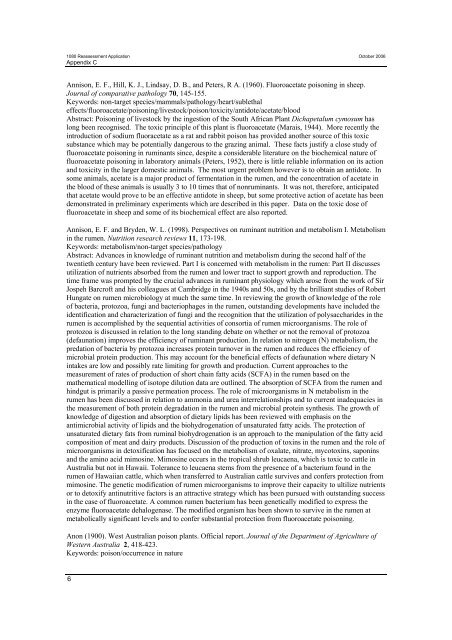Source: Landcare Research (1964). Control of poisons. Royal ...
Source: Landcare Research (1964). Control of poisons. Royal ...
Source: Landcare Research (1964). Control of poisons. Royal ...
You also want an ePaper? Increase the reach of your titles
YUMPU automatically turns print PDFs into web optimized ePapers that Google loves.
1080 Reassessment Application October 2006<br />
Appendix C<br />
Annison, E. F., Hill, K. J., Lindsay, D. B., and Peters, R A. (1960). Fluoroacetate poisoning in sheep.<br />
Journal <strong>of</strong> comparative pathology 70, 145-155.<br />
Keywords: non-target species/mammals/pathology/heart/sublethal<br />
effects/fluoroacetate/poisoning/livestock/poison/toxicity/antidote/acetate/blood<br />
Abstract: Poisoning <strong>of</strong> livestock by the ingestion <strong>of</strong> the South African Plant Dichapetalum cymosum has<br />
long been recognised. The toxic principle <strong>of</strong> this plant is fluoroacetate (Marais, 1944). More recently the<br />
introduction <strong>of</strong> sodium fluoracetate as a rat and rabbit poison has provided another source <strong>of</strong> this toxic<br />
substance which may be potentially dangerous to the grazing animal. These facts justify a close study <strong>of</strong><br />
fluoroacetate poisoning in ruminants since, despite a considerable literature on the biochemical nature <strong>of</strong><br />
fluoroacetate poisoning in laboratory animals (Peters, 1952), there is little reliable information on its action<br />
and toxicity in the larger domestic animals. The most urgent problem however is to obtain an antidote. In<br />
some animals, acetate is a major product <strong>of</strong> fermentation in the rumen, and the concentration <strong>of</strong> acetate in<br />
the blood <strong>of</strong> these animals is usually 3 to 10 times that <strong>of</strong> nonruminants. It was not, therefore, anticipated<br />
that acetate would prove to be an effective antidote in sheep, but some protective action <strong>of</strong> acetate has been<br />
demonstrated in preliminary experiments which are described in this paper. Data on the toxic dose <strong>of</strong><br />
fluoroacetate in sheep and some <strong>of</strong> its biochemical effect are also reported.<br />
Annison, E. F. and Bryden, W. L. (1998). Perspectives on ruminant nutrition and metabolism I. Metabolism<br />
in the rumen. Nutrition research reviews 11, 173-198.<br />
Keywords: metabolism/non-target species/pathology<br />
Abstract: Advances in knowledge <strong>of</strong> ruminant nutrition and metabolism during the second half <strong>of</strong> the<br />
twentieth century have been reviewed. Part I is concerned with metabolism in the rumen: Part II discusses<br />
utilization <strong>of</strong> nutrients absorbed from the rumen and lower tract to support growth and reproduction. The<br />
time frame was prompted by the crucial advances in ruminant physiology which arose from the work <strong>of</strong> Sir<br />
Jospeh Barcr<strong>of</strong>t and his colleagues at Cambridge in the 1940s and 50s, and by the brilliant studies <strong>of</strong> Robert<br />
Hungate on rumen microbiology at much the same time. In reviewing the growth <strong>of</strong> knowledge <strong>of</strong> the role<br />
<strong>of</strong> bacteria, protozoa, fungi and bacteriophages in the rumen, outstanding developments have included the<br />
identification and characterization <strong>of</strong> fungi and the recognition that the utilization <strong>of</strong> polysaccharides in the<br />
rumen is accomplished by the sequential activities <strong>of</strong> consortia <strong>of</strong> rumen microorganisms. The role <strong>of</strong><br />
protozoa is discussed in relation to the long standing debate on whether or not the removal <strong>of</strong> protozoa<br />
(defaunation) improves the efficiency <strong>of</strong> ruminant production. In relation to nitrogen (N) metabolism, the<br />
predation <strong>of</strong> bacteria by protozoa increases protein turnover in the rumen and reduces the efficiency <strong>of</strong><br />
microbial protein production. This may account for the beneficial effects <strong>of</strong> defaunation where dietary N<br />
intakes are low and possibly rate limiting for growth and production. Current approaches to the<br />
measurement <strong>of</strong> rates <strong>of</strong> production <strong>of</strong> short chain fatty acids (SCFA) in the rumen based on the<br />
mathematical modelling <strong>of</strong> isotope dilution data are outlined. The absorption <strong>of</strong> SCFA from the rumen and<br />
hindgut is primarily a passive permeation process. The role <strong>of</strong> microorganisms in N metabolism in the<br />
rumen has been discussed in relation to ammonia and urea interrelationships and to current inadequacies in<br />
the measurement <strong>of</strong> both protein degradation in the rumen and microbial protein synthesis. The growth <strong>of</strong><br />
knowledge <strong>of</strong> digestion and absorption <strong>of</strong> dietary lipids has been reviewed with emphasis on the<br />
antimicrobial activity <strong>of</strong> lipids and the biohydrogenation <strong>of</strong> unsaturated fatty acids. The protection <strong>of</strong><br />
unsaturated dietary fats from ruminal biohydrogenation is an approach to the manipulation <strong>of</strong> the fatty acid<br />
composition <strong>of</strong> meat and dairy products. Discussion <strong>of</strong> the production <strong>of</strong> toxins in the rumen and the role <strong>of</strong><br />
microorganisms in detoxification has focused on the metabolism <strong>of</strong> oxalate, nitrate, mycotoxins, saponins<br />
and the amino acid mimosine. Mimosine occurs in the tropical shrub leucaena, which is toxic to cattle in<br />
Australia but not in Hawaii. Tolerance to leucaena stems from the presence <strong>of</strong> a bacterium found in the<br />
rumen <strong>of</strong> Hawaiian cattle, which when transferred to Australian cattle survives and confers protection from<br />
mimosine. The genetic modification <strong>of</strong> rumen microorganisms to improve their capacity to ultilize nutrients<br />
or to detoxify antinutritive factors is an attractive strategy which has been pursued with outstanding success<br />
in the case <strong>of</strong> fluoroacetate. A common rumen bacterium has been genetically modified to express the<br />
enzyme fluoroacetate dehalogenase. The modified organism has been shown to survive in the rumen at<br />
metabolically significant levels and to confer substantial protection from fluoroacetate poisoning.<br />
Anon (1900). West Australian poison plants. Official report. Journal <strong>of</strong> the Department <strong>of</strong> Agriculture <strong>of</strong><br />
Western Australia 2, 418-423.<br />
Keywords: poison/occurrence in nature<br />
6








![Application for test certificate [pdf, 131kb]](https://img.yumpu.com/50666502/1/184x260/application-for-test-certificate-pdf-131kb.jpg?quality=85)








